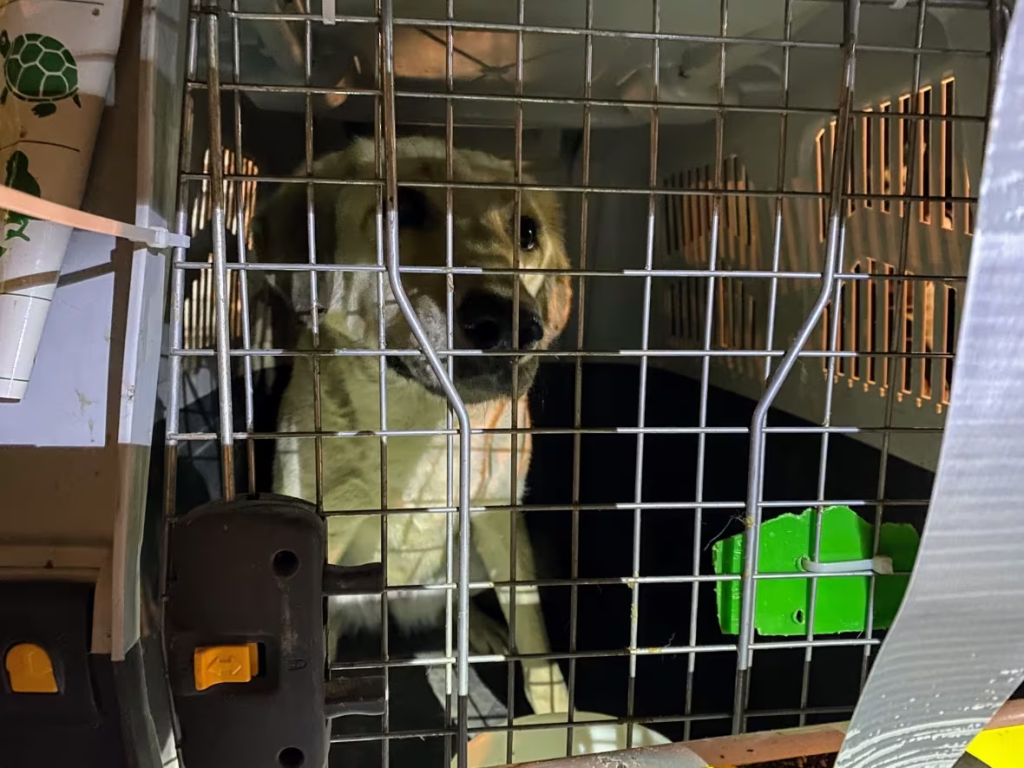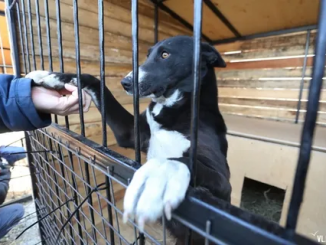
A routine trip to the vet for bad breath turned into heartbreaking news for Kermie’s family. The 11-year-old Lab-Beagle-Chow Chow mix, beloved by Eric Ralston, a principal hospital corpsman in the US Navy, had been diagnosed with oral carcinoma.
The grim prognosis gave Kermie only two to three months to live, leaving her family devastated. Little did they know that Kermie had her own plans, and she refused to say goodbye until her cherished owner returned home from his nine-month deployment.

Eric Ralston had been stationed overseas in March, leaving behind his loving family, including Kermie. When Kermie’s bad breath raised concerns, Eric’s wife took her to the vet for an examination. The devastating diagnosis of cancer shattered their hearts, as Kermie had been their first “fur child,” and they couldn’t fathom Eric missing the chance to see her again.
As time passed, Kermie defied the odds and continued to thrive. Three months turned into several, and hope began to flicker within the Ralston family. With Eric’s deployment nearing its end, they dared to dream that Kermie might get the chance to reunite with him.

However, just 12 days before Eric was scheduled to return home, his deployment was extended, dashing their hopes. The approaching holidays intensified their worry, with Christmas on the horizon, and Kermie’s condition remained uncertain. Still, Kermie persevered, displaying a remarkable will to see Eric once more.
Then, a Christmas miracle unfolded. Eric’s homecoming came earlier than expected, and Kermie was there to welcome him. Adorned with a red bow, she sprinted from the house and into Eric’s loving arms. The reunion breathed new life into Kermie, who had been on her last leg. Eric’s presence was a magic elixir for her, rekindling her appetite and zest for life.

Jennifer Ralston, Kermie’s human mom, remarked, “His return was some kind of magic lozenge for her.” The once-struggling Kermie was now eating and drinking without difficulty, savoring each moment of happiness with Eric by her side. In January, Kermie celebrated her 12th birthday, a testament to her enduring spirit.
However, February brought a turn for the worse. The good days became fleeting, and the Ralston family knew the time had come to make a difficult decision. On February 22nd, Kermie lost her battle with cancer, surrounded by Eric and her loving family.

Kermie’s story is a poignant reminder of the bond between humans and their canine companions. It showcases the incredible resilience and unwavering love that dogs bring into our lives. Though Kermie’s battle ended, her legacy of love and determination lives on, reminding us of the power of unconditional love between pets and their owners.
Please share this heartwarming tale with your friends to celebrate Kermie’s life and the enduring bond between dogs and their humans.
Planeload of abandoned dogs and cats from Afghanistan arrives in Vancouver
Some of the animals will be reunited with their owners while others will be put up for adoption

Hundreds of animals stranded in Afghanistan arrived in Vancouver on Tuesday night, after more than six months of rescue efforts by the Society for the Prevention of Cruelty to Animals (SPCA).
A total of 158 dogs and 146 cats touched down at Vancouver International Airport (YVR) aboard a specially converted Russian Ilyushin 76-TD aircraft after stops in Turkey and Iceland.
SPCA International said partners in Kabul reached out to them regarding the pets when U.S. forces withdrew from Afghanistan.
The groups hoped to evacuate the animals to North America at the time of the withdrawal, but the volatile situation combined with logistical issues resulted in the delay.

“These animals have been on the plane for quite some time,” Lori Kalef, director of programs for SPCA International, said prior their arrival. “We had to reroute at the last minute due to the conflict going on in Russia.”
From YVR, the animals will be transferred to a specially constructed 1,600-square metre facility.
Kalef said about 66 of the animals will be reunited with their owners, while another two dozen will stay with the SPCA until their owners are able to retrieve them.

The others will be put up for adoption across North America.
Anyone interested in adopting one of the animals can visit the SPCA International website. Applications will be handled by SPCA International and the B.C.-based RainCoast Dog Rescue Society.
Treacherous rescue mission
In a statement, the SPCA said numerous pets were left behind in shelters when their owners fled the country following the Taliban takeover.
A local charity, Kabul Small Animal Rescue, had saved more than 70 dogs from Kabul International Airport and rescued dozens of other animals abandoned by owners when they were forced to flee.



Leave a Reply